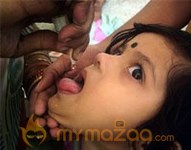Polio, also called poliomyelitis is a highly contagious infectious disease caused by one of three related viruses. Polio is a very serious disease, which can lead to paralysis or even death. Once a person is exposed to polio, it usually takes about three to five days for symptoms to appear.
In about 95 percent of polio cases, infection from the polio virus causes no symptoms or serious effects. In about 5 percent of cases, the polio virus manifests in a mild form (abortive polio) with flu-like symptoms, in a nonparalytic form (aseptic meningitis) or in a severe form called paralytic polio. People who have minor or nonparalytic forms recover completely.
Causes of Polio:
Polio is caused by infection with the poliovirus. This virus is highly contagious, and is passed on through food and water contaminated with the stool (feces) of infected people. It can take between four and 35 days before symptoms appear and an infected person can pass the virus on to other people even before symptoms appear.
Infection with polio happens when the virus enters the body through the mouth, multiplies in the throat and intestine, and spreads through the blood to the nervous system. There, the virus attacks nerve cells, which can lead to paralysis.
Symptoms of Polio:
Polio is a serious condition that causes paralysis in about 1% of those infected (paralytic polio). However, most people do not become sick at all. In a small number of cases, the disease causes flu-like symptoms but does not lead paralysis (nonparalytic polio).
Nonparalytic polio causes symptoms that mimic the flu. A person may experience a sore throat, fatigue, nausea, diarrhea, a fever, or vomiting. Most cases of nonparalytic polio clear up in a number of days, but a some people go on to develop meningitis, a condition in which the lining of the brain is infected. Meningitis can be fatal if it is not treated quickly.
When a person develops paralytic polio, the symptoms are more serious. As the virus spreads through the nerves it destroys nerves that control muscles. The infection may be fatal if the brain and respiratory organs become affected.
Treating and Preventing Polio:
Because there is no cure for polio, supportive therapy is the main treatment. Improving a person's chance of recovery is the main goal of treatment. This type of treatment helps minimize discomfort and prevent complications while the person heals. Supportive treatment may include medications for polio symptoms, ventilators to help the person breathe, exercise, and a balanced diet.
Polio is not a treatable disease, yet it is almost completely preventable. Vaccination with the polio vaccine provides the most effective form of prevention. Childhood immunization programs protect Canadians from infection by the poliovirus.
Post Polio Syndrome:
Post polio syndrome is a condition that affects polio survivors anywhere from 10 to 40 years after recovery from an initial paralytic attack of the poliomyelitis virus. Post-polio syndrome is characterized by a further weakening of muscles that were previously affected by the polio infection.
Post polio syndrome is a very slowly progressing condition marked by long periods of stability. The severity of post-polio syndrome depends on the degree of the residual weakness and disability an individual has after the original polio attack. People who had only minimal symptoms from the original attack and subsequently develop post-polio syndrome will most likely experience only mild post-polio syndrome symptoms. People originally hit hard by the polio virus, who were left with severe residual weakness, may develop a more severe case of post-polio syndrome with a greater loss of muscle function, difficulty in swallowing, and more periods of fatigue
Post polio syndrome is rarely life-threatening. Post-polio syndrome is also called PPS.
Symptoms of Post Polio Syndrome
Some of the symptoms of post polio syndrome are:
unexplained fatigue
new weakness in muscles
pain in muscles or joint
scoliosis
breathing difficulties
swallowing problems
depression
muscle spasms/twitching
sleep problems
anxiety
weakness and muscle atrophy
Treatment for Post polio syndrome:
Post polio syndrome can be treated . Treatments are focused on reducing the severity of the symptoms.
Massage applied to remedy polio in Ayurvedic:
As possibly befits the remedy for such a deadly serious disease like polio, Ayurvedic prescribes arguably its most important massage form in the treatment of the disease, namely the method known as Pindasvedka or Navarakizhi.
This treatment revitalizes mainly the skin and is also used with Ayurvedic anti ageing treatments. However in achieving this it also rejuvenates dead and wasted muscles which is why it is used as a remedy for paralysis, which is why it used on polio sufferers.
Herbs and spices in treating Polio:
Fennel
Ginger
Black pepper
Coriander
Licorice












